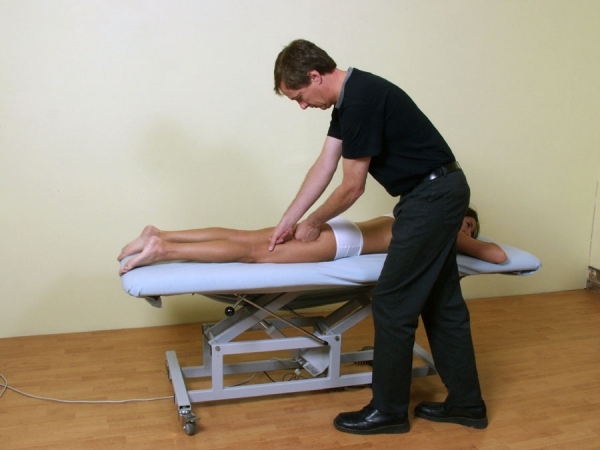Like most theories, the "body-weight" approach, commonly advanced as the best way to work, has a kernel of truth in it. Put amass at the end of a lever and there's potential there for getting some work done. The bigger the mass, the better the advantage. It's so attractive on paper! And it even hints at the possibility of using something other than our personal version of brute strength to get out goals accomplished. This of course is a useful perspective to explore, especially for those of us who are not naturally endowed with brute-strength.
Regrettably, this body-weight approach has serious shortcomings. It even contributes to the very musculoskeletal ailments that therapists are trying to avoid or overcome. It places strain on the shoulder joints, causes compression of the thoracic outlet and contributes to forward head posture and scapular instability. Yikes. The list of possible symptoms includes: supraspinatus: inflammation; ligamentous laxity at the gleno-humeral joints; loss of strength and sensation in the hand and fingers; TMJ pain; bruxism; upper thoracic and cervical facet joint dysfunctions; and serious breathing pattern disorders.
How can therapists move away from this scenario, of the therapist diligently leaning, even slumping onto the patient's body? Or the other common scenario, of therapists working with intense, unsustainable muscular effort, that leaves them exhausted at the end of even one or two treatments?
Developing appropriate muscle tone is the answer. In a nutshell this means, above all else, cultivating stability via activation of the body's tonic gravity-response systems. These systems are often identified in terms of key structures, especially the transversus abdominus and more generally, the "core".
For the purposes of this article "core" will be defined as a process of co-ordination, not just the action of a few isolated structures. "Core" can be seen as a process, a kinetic-melody if you like, not simply the activation of a few lower abdominal and pelvic floor muscles.
Stability itself can in turn be divided into two main areas – global stability and local stability. The first is concerned with broad relationships between the major segments of the body. Local stability is to do with the amount of control at individual joints. This article looks at the importance of both for the long-term well-being of the therapist.
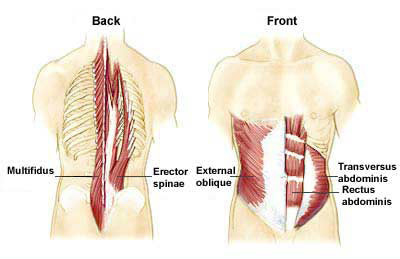 The role of transversus abdominus (TA), the internal oblique and pelvic floor muscles in providing support for the low-back and viscera has been acknowledged and explored clinically by Rolf and Pilates.2,3,4 Recent studies have significantly elaborated upon these original concepts and techniques. TA is identified as being synergistically involved with the thoracolumbar fascia, multifidus and pelvic floor to provide stability for the pelvis and trunk.5 Of significant interest for the therapist in search of a stable, pain-free body it was shown that in the population with a normal functioning, pain-free back the first muscle to contract with movement of the extremities was, in fact,TA. This is true no matter what direction the extremity is moved. The authors of this study termed this desirable activation of the TA as the "generation of a non-direction-specific stiffness of the spine".5 A preparatory stabilising of the trunk occurs a few milliseconds before the arm or leg moves. If it has its druthers the body puts stability ahead – just a few milliseconds though - of movement through space. This is one of the most important pieces in the puzzle of trying to get therapists' bodies to be more resilient as they work.
The role of transversus abdominus (TA), the internal oblique and pelvic floor muscles in providing support for the low-back and viscera has been acknowledged and explored clinically by Rolf and Pilates.2,3,4 Recent studies have significantly elaborated upon these original concepts and techniques. TA is identified as being synergistically involved with the thoracolumbar fascia, multifidus and pelvic floor to provide stability for the pelvis and trunk.5 Of significant interest for the therapist in search of a stable, pain-free body it was shown that in the population with a normal functioning, pain-free back the first muscle to contract with movement of the extremities was, in fact,TA. This is true no matter what direction the extremity is moved. The authors of this study termed this desirable activation of the TA as the "generation of a non-direction-specific stiffness of the spine".5 A preparatory stabilising of the trunk occurs a few milliseconds before the arm or leg moves. If it has its druthers the body puts stability ahead – just a few milliseconds though - of movement through space. This is one of the most important pieces in the puzzle of trying to get therapists' bodies to be more resilient as they work.
This preparatory "pre-movement" requires coordinated activity - the kinetic melody - within the central nervous system (CNS). Establishing these new neuromuscular responses is central to the solution to therapist strain. A powerful way to activate this melody is to attend, with deliberate awareness, to the sensory/proprioceptive inputs to the CNS. Put in the simplest terms it means paying attention to sensations of temperature, pressure, spatial position and change of position. It’s really an amplification process – the inputs are always there but deliberate awareness turns the volume up. It’s surprisingly easy to do this and once the benefits are enjoyed, doing the multiple repetitions required to learn the new behaviours is easy.
Start with movements that are initiated with a specific sense of direction. Moving in this way involves the proprioceptors – position sensing nerves in and around the joints as well as the fascia – informing the motor cortex of the outputs necessary for economical tonic function.6, 7 Alexander frequently noted that movement made with a specific sense of direction produced a sequence of muscle activation that resulted in less effort.6
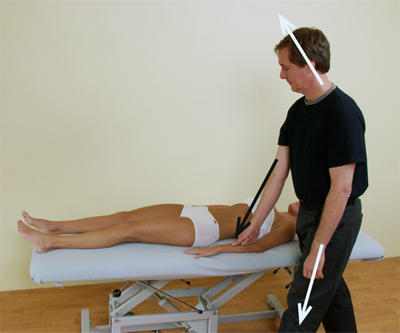 The movements should be explored via the imagination as well. In the work of ideokinesis, Todd proposed that new movements are learned when they are introduced through imagery and prolonged periods of self-sensing. Both approaches provide access to the "invisible" gamma nervous system, the background system responsible for setting tone. The gamma system regulates the tone in the gravity-response or tonic muscles where there is a high proliferation of muscle spindles and greater sensitivity to stretch. Appropriate resting tone is maintained via the the so called Gamma bias. In contrast, Gamma gain is a situation of hypertonicity associated with increasing sensitivity of the stretch receptors.8,9
The movements should be explored via the imagination as well. In the work of ideokinesis, Todd proposed that new movements are learned when they are introduced through imagery and prolonged periods of self-sensing. Both approaches provide access to the "invisible" gamma nervous system, the background system responsible for setting tone. The gamma system regulates the tone in the gravity-response or tonic muscles where there is a high proliferation of muscle spindles and greater sensitivity to stretch. Appropriate resting tone is maintained via the the so called Gamma bias. In contrast, Gamma gain is a situation of hypertonicity associated with increasing sensitivity of the stretch receptors.8,9
For the working therapist many of these ideas can be explored "on the job". The goal here is to explore in a curious, light-hearted manner as this is the way in which new behaviours are most easily learned. Focus on one aspect of this at a time – first the feet feel through and "receive through into the marrow of the bones" the ground; then go up through to the sky "like a mushroom lightly pushing out of the ground for
the very first time" via the top of the head. Once this span between earth and sky is established, reach away through the arms. This reaching will draw the scapula away from the ears and help them to "live with the ribs". Contrast this "reaching" action with pushing or leaning. Notice the various pressures, tensions and shapes that are formed with each approach.
Next add a direction for the scapula and guide them toward the ground "like they're running on a river of water down over the ribs towards the earth" while maintaining the reach of the arms. This will often result in a sense of moving "up-and-away" from the client – standing back further with lots of open angles at the major joints. A general sense of verticality and span will often be experienced. This will be done without any increase in muscular effort. In fact, it will very likely have led to a decrease in muscular effort and a beautiful sense of being better connected with the client.
This is a broad approach to repatterning – developing the kinetic melody that flows on from opening up the sensory and proprioceptive pathways that inform the CNS of how to develop appropriate tone via changes in the gamma system.
Some joints are sufficiently unstable that they are incapable of responding to this approach alone. The same studies that showed the stabilising pre-movement of the TA in extremity movements, also discovered that the multifidus muscles, responsible for segmental stability in the spine, - one vertebra in relation to another - quickly lose tone and volume when there is back pain.5 In these instances of chronic dysfunction of a small intrinsic muscle more specific attention to facilitating muscle firing is required. This kind of specific, local re-patterning is best done out of the working environment where it's possible to generate a nuanced and discrete awareness of small movements.
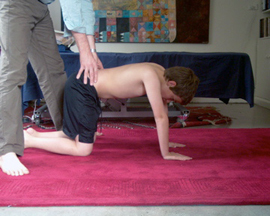
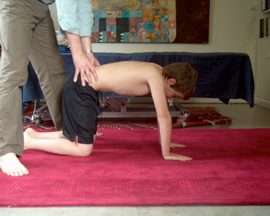
Here's a method for working with the multifidus. Work with a partner. Adopt the four point kneel and develop a deliberate sense of connection through the hands and knees with the floor. Allow the sensations of pressure and temperature to be fully received. Next, reach away through the top of the head "swelling into the space just above the crown". Then reach out through the tail-bone in the other direction "towards the wall behind" and sense the span that has now been developed in the body.The TA and obliques may well have activated and drawn the abdomen towards the spine with an attendant delicious sense of tone through the whole trunk. Now have the standing partner locate the unstable/painful segment and apply pressure to it bilaterally via the thumbs. Once moderate, sustained pressure is established, the person on the floor can explore a micro movement. Lower the vertebra towards the floor a centimetre or two. Control this motion – don't let it slump. Next, swell the vertebra up into the pressure of the thumbs. Again, just a few centrimetres of movement in space is all that is required. Oscillate through these two positions a number of times, paying attention to the directions of head and tail-bone that have already been established. Six or seven oscillations will be sufficient. Go to standing and observe how that area of the back feels as well as the overall orientation of the spine. Common outcomes include diminished pain at the joint as well as less-effortful support for the spine as the intrinsic muscles activate to provide segmental stability and diminish the demands on the larger erector muscles.
References
1. AMTA [homepage on the Internet]. Evanston, IL: AMTA; c2000-2007 [cited 2007 Mar 27]. Online Survey. Available from: http://www.amtamassage.org/survey/takesurvey
2. Rolf I. Rolfing:The integration of human structures. New York: Harper and Row; 1978
3. Pilates J. Return to life through contrology. Nevada: Presentation Dynamics Inc.; 1998
4. Physical Mind Institute. Anatomy of pilates. New York: Physical Mind Institute; 2001
5. Richardson C, Jull G, Hodges P, Hides J.Therapeutic exercise for spinal segmental stabilization in low back pain: scientific basis and clinical approach. Edinburgh: Churchill-Livingstone; 1999
6. de Aleantara P. Forward and up: An introduction to the alexander technique. [cited 2007 July 11] Available from: http://www.pedrodeal-cantara.com/forward_body.html
7. Frank K., McHose, How life moves. Berkeley: North Atlantic Press; 2007
8. Bernard A, Steinmüller W, Stricker, U. Ideokinesis: a creative approach to human movement and body alignment. Berkeley: North Atlantic Press, 2007
9. Juhan, D. Job's body. New York: Station Hill Press; 1987


